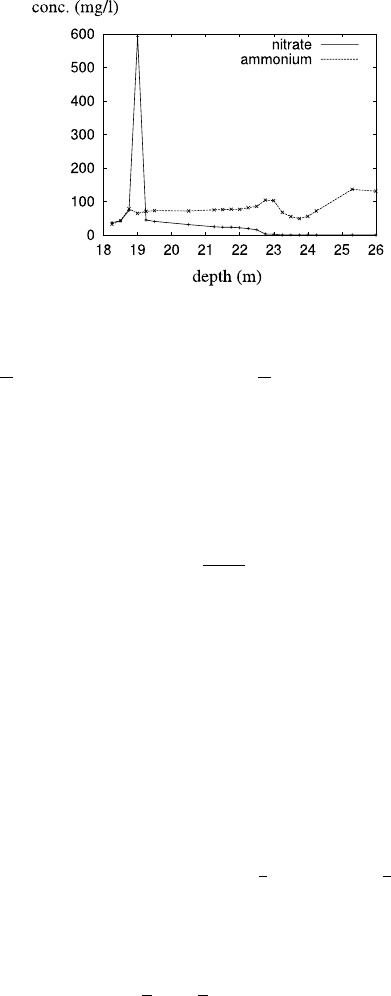Fowler A. Mathematical Geoscience
Подождите немного. Документ загружается.


430 7 Groundwater Flow
Fig. 7.9 Data from borehole 102 at Rexco, May 2003, courtesy of David Lerner and Arnë
Huttmann, GPRG, University of Sheffield. Units are metres for depth, mg l
−1
for concentrations.
Since the molecular weights of ammonium and nitrate are 18 and 62 (g mole
−1
), respectively, then
1mgNH
+
4
l
−1
=
1
18
mmol NH
+
4
l
−1
,1mgNO
−
3
l
−1
=
1
62
mmol NO
−
3
l
−1
. Nitrate shows a sharp
spike (of about 10 mmol l
−1
) at a depth of 19 m. There appears to be a second front at 23 m: the
nitrate produced at 19 m diffuses there and takes out (according to (7.201)) either the inorganic
carbon CH
2
O or the acid H
+
where the parameters ν
i
are defined analogously to (7.194), i.e.,
ν
i
=
ˆc
i
ˆc
NH
+
4
, (7.205)
ˆc
i
being the scale for c
i
. From the values given above, we can suppose that all the
ν
i
1.
We now mirror the Four Ashes discussion, supposing that Λ 1. The reaction
front at the plume fringe should then be thin as before, with oxygen diffusing to
the front from outside the plume, and ammonium diffusing to it from inside, and
both concentrations being zero at the front. The fringe position is unknown, and we
seek a conservation law to provide an extra condition for it analogous to (7.197).
Denote the right hand sides of (7.202)bye
1
–e
5
. There are five reactants but only
three reactions, therefore there are two (linear) relationships between the e
i
: these
provide suitable jump conditions across the fringe. The equations
i
β
i
e
i
=0are
satisfied for any β
1
and β
2
provided β
3
=−β
1
+
1
2
β
2
, β
4
=β
1
+
3
4
β
2
, and β
5
=−β
2
.
Selecting (β
1
,β
2
) =(1, 0) and (0, 1), we thus have
e
1
−e
3
+e
4
=0,
e
2
+
1
2
e
3
+
3
4
e
4
−e
5
=0,
(7.206)
and it follows from this that in consideration of (7.204) there are two conserved
quantities across the fringe (i.e., flux in equals flux out); explicitly (with the same

7.8 Three Specific Remediation Problems 431
caveat concerning the normal n as expressed in (7.199)), we have
∂c
NH
+
4
∂n
−ν
NO
−
3
∂c
NO
−
3
∂n
+ν
H
+
∂c
H
+
∂n
+
−
=0,
ν
O
2
∂c
O
2
∂n
+
1
2
ν
NO
−
3
∂c
NO
−
3
∂n
+
3
4
ν
H
+
∂c
H
+
∂n
−ν
CH
2
O
∂c
CH
2
O
∂n
+
−
=0,
(7.207)
where [j ]
+
−
denotes the jump in j across the fringe.
Consulting (7.201), we can write the dimensionless reaction rates r
i
in terms of
Monod rates
M
i
=
c
i
K
i
+c
i
(7.208)
in the following way:
r
1
=M
NH
+
4
M
O
2
,r
2
=k
2
M
NO
−
3
M
H
+
M
CH
2
O
,r
3
=k
3
M
NH
+
4
M
NO
−
3
,
(7.209)
where k
2
and k
3
are dimensionless constants (the ratios of the saturated maxima
k
max
of reactions 2 and 3 in (7.201) to that of reaction 1). The requirement that re-
action rates vanish on either side of the fringe is satisfied if c
NH
+
4
= 0 outside the
plume (then r
1
=r
3
=0), c
O
2
=0 within the plume (so r
1
=0) and if c
NO
−
3
=0on
both sides (then r
2
=r
3
=0). This simplifies the situation to one where pre-existing
soil nitrate concentrations are low, and assumes all the nitrate produced in the re-
action front by reaction 1 is consumed there by reaction 2. An alternative would be
that the produced nitrate diffuse away on either side, but this is not consistent with
a fast reaction 2 unless there is a natural source for nitrate production (e.g., from
surface composting).
11
Since from (7.203), ν
H
+
∼ 10
−5
, this suggests that
∂c
NH
+
4
∂n
is approximately continuous across the fringe, which is thus diffusive in character
(providing Pe 1). In that case the fringe is located simply by advection of ammo-
nium.
The second jump condition then provides a flux boundary condition for c
CH
2
O
,
which is not constrained to be zero at the front. In addition, existence of a spike of ni-
trate within the front must be determined by solution of the reaction equations within
the front. The reaction front is of thickness ∼(1/ΛPe)
1/2
(taking Pe
=Pe
⊥
for sim-
plicity), and within this front, the nitrate concentration is given approximately by
∂
2
c
NO
−
3
∂N
2
+ν
NO
−
3
(r
1
−r
2
−0.6r
3
) =0, (7.210)
11
Alternatively, there may be more than one reaction front. This is suggested by Fig. 7.9.

432 7 Groundwater Flow
where N is a suitably rescaled normal variable. We can expect this to be solv-
able for c
NO
−
3
subject to c
NO
−
3
→ 0asN →±∞, since for example if we lin-
earise the nitrate Monod coefficient, M
NO
−
3
=c
NO
−
3
, then the solution can be written
using a Green’s function which depends also on all the other reactant concentra-
tions.
There remains the issue of determining a boundary condition for H
+
at the front.
Counting conditions, the first flux condition in (7.207) determines the location of the
fringe. We already have boundary conditions for c
NH
+
4
and c
O
2
(both equal zero),
and the nitrate spike is determined from (7.210). Thus, in principle we know the
jump in flux of ammonium, oxygen and nitrate, and by integrating (7.210) and its
equivalents for ammonium and oxygen through the front, we know that
∞
−∞
(r
1
+r
3
)dN =
∂c
NO
−
3
∂N
+
−
,
ν
O
2
∞
−∞
2r
1
dN =
∂c
O
2
∂N
+
−
, (7.211)
ν
NO
−
3
∞
−∞
−(r
1
−r
2
−0.6r
3
)dN =0.
Thus we know the values of
∞
−∞
r
i
dN for i =1, 2, 3 and this tells us (by integrating
through the reaction front) the values of
∞
−∞
r
i
dN for i =4, 5, and thus the jump in
flux of
∂c
H
+
∂N
; this provides the extra boundary condition we seek. The jump in flux
of c
CH
2
O
is also given by
∞
−∞
1.25ν
CH
2
O
r
2
dN, but this is equivalent to (7.207)
2
.In
this way, the approximate model provides all the conditions necessary to determine
the solution.
St. Alban’s At St. Alban’s, there has been a petroleum spillage (at a filling station)
into an underlying chalk aquifer. The fluids are LNAPLs: hydrocarbons, BTEX (a
cancer-forming aromatic hydrocarbon
12
and MTBE.
13
BTEX is retarded compared
to MTBE and thus forms a secondary plume within the MTBE plume. The LNAPLs
have seeped through the unsaturated zone and sit on top of the chalk aquifer, act-
ing as a source (via dissolution) of contaminant to the underlying groundwater
flow.
The sequence of reactions appears to be similar to those of the other examples,
with oxidation by oxygen and nitrate at the plume fringe, and by Mn (manganese),
Fe (iron) and SO
2−
4
(sulphate) in the plume core. The sequence of reactions which
12
More specifically, BTEX refers to a suite of volatile hydrocarbons, the acronym referring to ben-
zene, toluene, ethylbenzene and xylene, with chemical formulae C
6
H
6
(benzene), C
7
H
8
(toluene),
C
8
H
10
(ethylbenzene and xylene); we use toluene in the chemical reaction model.
13
Methy tert-butyl ether, C
5
H
12
O.
7.8 Three Specific Remediation Problems 433
are modelled is the following:
C
7
H
8
+9O
2
+3H
2
O
r
1
→ 7CO
2−
3
,
C
7
H
8
+7.5H
2
O
r
2
→ 2.5CO
2−
3
+4.5CH
4
+5H
+
,
C
7
H
8
+36Fe
3+
r
3
→ 7CO
2−
3
+36Fe
2+
+50H
+
,
CH
4
+2O
2
r
4
→ CO
2−
3
+2H
+
+H
2
O,
CH
4
+8Fe
3+
+3H
2
O
r
5
→ CO
2−
3
+8Fe
2+
+10H
+
,
Fe
2+
+O
2
+H
+
r
6
→ Fe
3+
+0.5H
2
O,
C
7
H
8
+36FeOOH
(s)
+58H
+
r
7
→ 36Fe
2+
+7CO
2−
3
+51H
2
O,
CH
4
+8FeOOH
(s)
+7H
+
r
8
→ 8Fe
2+
+CO
2−
3
+5H
2
O.
(7.212)
Maximum reaction rates vary over about four orders of magnitude, from about
10
−12
mol l
−1
s
−1
(reactions 2, 3, 7) to 10
−8
mol l
−1
s
−1
(reaction 8). The princi-
pal oxidising reaction rate r
1
∼10
−10
mol l
−1
s
−1
. Contaminant levels are of order
10
−7
mol l
−1
, with oxygen level of order 10
−6
mol l
−1
. Plume depth and length are
d ∼ 20 m, l ∼ 300 m, dispersivity parameters are taken as α
∼ 1m,α
⊥
∼ 0.2m.
The hydraulic conductivity of the upper chalk aquifer is 25 m d
−1
(that of the lower
part is only about 0.1 m d
−1
), and the hydraulic gradient is 1.75 ×10
−3
, thus the
longitudinal flux scale is U ∼16 m y
−1
. With these values, the parameters defined
by (7.186) have values
Pe
∼300, Pe
⊥
∼10,Λ∼10
6
. (7.213)
As now seems monotonously to be the case, reactions are fast, longitudinal disper-
sion is small, but transverse dispersion may be effective because of the high aspect
ratio l/d.
The distinguishing feature of this particular site is that, although the chalk is very
porous (φ 0.3), it has a very low effective permeability, presumably due to chem-
ical adsorption by the chalk. On the other hand, the chalk matrix is dissected into
blocks by numerous fractures, and thus acts as a dual porosity system. Contaminant
can diffuse into the pore space of the matrix, and the issue of concern is whether and
how fast this happens, since storage in matrix blocks will act as a residual source of
contamination after the fracture system has been flushed.
We have considered this problem before, in Sect. 7.6.1. Let us suppose for sim-
plicity that dispersivities of matrix and fractures are constant and isotropic but not
necessarily equal. (Additionally, we suppose the local fracture dispersivity D
f
is
equal to the macroscopic fracture dispersivity D
F
.) The point forms of the equations
describing a single reactant are given by (7.165), and the block scale and averaged

434 7 Groundwater Flow
equations for the matrix concentration are given by (7.167) and (7.170):
Pe
m
∂ ¯c
m
∂t
+
¯
u
m
.∇
x
¯c
m
=∇
2
x
¯c
m
+Pe
m
Λ
¯
S
m
+
1
ε
2
n.∇
X
c
m
|
∂M
,
εPe
m
∂c
m
∂T
+u
m
.∇
X
c
m
=∇
2
X
c
m
+ε
2
Pe
m
ΛS
m
,
(7.214)
where
Pe
m
=
Ul
D
m
,Λ=
S
0
l
Uc
0
. (7.215)
Analogous dimensionless forms for the fracture average and block scale equations
are, from (7.162) and (7.165)
2
,
Pe
f
∂ ¯c
f
∂t
+
¯
u
f
.∇
x
¯c
f
=∇
2
x
¯c
f
+Pe
f
Λ
¯
S
f
−
D
m
ε
2
D
f
φ
f
n.∇
X
c
m
|
∂M
,
εPe
f
∂c
f
∂T
+u
f
.∇
X
c
f
=∇
2
X
c
f
+ε
2
Pe
f
ΛS
f
−
D
m
D
f
φ
f
(n.∇
X
c
m
)|
∂M
,
(7.216)
and Pe
f
=Ul/D
f
.
The question is how the interfacial transport term should be modelled. In princi-
ple we solve the block equation for c
m
with c
m
=c
f
on ∂M, yielding the interfacial
term as an integral convolution of c
f
. Putting this into the block equation for c
f
and
solving this then determines c
f
and thus gives the interfacial term, which closes the
description of the averaged equations.
The upshot of our earlier discussion was that the details of the homogenisation
process depend on the relation between the parameters ε = d
B
/l, Pe and Λ.Clas-
sical homogenisation theory as in Sect. 7.6.1 assumes all the parameters are O(1)
apart from ε, but this is unlikely ever to be appropriate. Estimates for St. Alban’s
may be Pe
f
∼10
2
, Λ ∼10
6
, ε ∼10
−4
; in addition, u
m
u
f
and D
m
D
f
. Thus
the reaction terms in the macroscopic equations are always large, and this suggests
that, as before, reactions will be restricted to thin fronts. A complication in (7.214)
is that the interfacial transport term may be large also, so this now needs to be de-
termined.
To be specific, let us consider a simple two component reaction similar to (7.191),
i.e.,
C
7
H
8
+σ O
2
r
→products, (7.217)
and let p denote dimensionless BTEX concentration and c denote dimensionless
oxygen concentration. Just as in (7.192), we can put S
m
=νS in (7.221), and there
is a corresponding reaction term S in the equivalent equation for p: S can be taken
as the product of Monod rates in (7.193), and for simplicity we take the linear rates,
thus S =−pc.

7.8 Three Specific Remediation Problems 435
The critical parameter in (7.214)
2
is ε
2
Pe
m
Λ; we write
B
m
=ε
2
Pe
m
Λ, B
f
=ε
2
Pe
f
Λ; (7.218)
if Pe
f
∼10
2
then B
f
∼O(1), and B
m
1: reaction in the block is fast.
Just as in (7.196), c
m
−νp
m
satisfies an advective-diffusion conservation equa-
tion in the block, diffusion acting on a time scale t ∼ε
2
Pe
m
, where t is the macro-
scopic time variable. The parameter ε
2
Pe
m
is crucial. If we suppose that molec-
ular diffusion applies in the blocks, then D
m
∼ 10
−9
m
2
s
−1
, Pe
m
∼ 10
5
, and
ε
2
Pe
m
∼ 10
−3
is small. Therefore on the long macroscopic time scale, diffusion
smoothes c
m
−νp
m
, and we can take it to be locally constant in the blocks (and thus
also the fractures). Since reaction is fast in the blocks, this implies
c
m
≈νp
m
, (7.219)
and therefore the block reaction rate for c
m
can be written as
ε
2
Pe
m
ΛS
m
≈−B
m
c
2
m
. (7.220)
When B
m
is large there is a reaction boundary layer like a rind at the block
surface, within which c
m
satisfies
∂
2
c
m
∂N
2
−B
m
c
2
m
≈0. (7.221)
In the interior of a block inside the plume the oxygen is depleted. and we have
c
m
→0asN →−∞. The first integral of (7.221) determines the flux to the blocks
as
∂c
m
∂N
=
2B
m
3
c
3/2
f
, (7.222)
using the fact that c
m
=c
f
on ∂M. The matrix concentration is negligible, and the
average fracture concentration satisfies the Eq. (7.216)
1
Pe
f
∂ ¯c
f
∂t
+
¯
u
f
.∇
x
¯c
f
=∇
2
x
¯c
f
−
B
f
ε
2
¯c
2
f
−
1
ε
2
φ
f
2B
f
Pe
f
3Pe
m
¯c
3/2
f
, (7.223)
where we take S
f
=−c
2
f
as in the matrix, and we have supposed that
c
2
f
=¯c
2
f
, c
3/2
f
=¯c
3/2
f
. (7.224)
With B
f
∼O(1), Pe
f
∼10
2
, Pe
m
∼10
5
, the flux term to the blocks,
B
f
ε
2
¯c
2
f
1 and
the fracture reaction term
1
ε
2
φ
f
2B
f
Pe
f
3Pe
m
¯c
3/2
f
1; the implication is that the fracture
concentration of oxygen within the plume rapidly decreases within both blocks and

436 7 Groundwater Flow
fractures to very small levels. The dual porosity appears to have little effect on the
characteristics of the reactant distributions.
7.9 Precipitation and Dissolution
A sedimentary basin, as illustrated in Fig. 7.10, refers to an accumulation of sedi-
ments (of typical depth 10 km) derived from river outwash sands and silts, or marine
deposited muds and microfossils. Sedimentary basins are everywhere in continen-
tal rocks: we have the Paris basin, the London basin, the North Sea, and so on.
As sediments accumulate and are buried, they are subjected to increasing heat and
pressure, and these two factors enable the formation of intergranular cements, which
thus convert the sediments to rock (sand to sandstone; clay to shale, marine organ-
isms to limestone). As they are buried, the sediments also compact, expelling pore
water. Depending on the permeability, this can lead to pore pressures above hydro-
static, a situation which is of concern in oil-drilling operations (and is discussed
further in Sect. 7.11).
Diagenesis refers generally to the process of chemical alteration to rock, and in
this section we study the effects of diagenesis on the groundwater flow of accumu-
lating sediments within a sedimentary basin. The particular type of diagenesis which
we discuss is the conversion of smectite (a form of hydrated clay) to illite (a dehy-
drated clay) via a dewatering reaction. The resultant release of water is also a poten-
tial cause of excess pore pressures, but the main purpose of the present discussion
is to show how the use of an approximation which we may call the weak solubility
limit allows enormous simplification of quite complicated reaction schemes.
One view of the smectite–illite reaction is to treat it using first order kinetics, thus
S
S
→I
S
+nH
2
O, (7.225)
where each mole conversion yields n moles of water: S denotes smectite, I denotes
illite, and the superscript
S
denotes the solid phase (likewise,
L
will denote an aque-
ous phase). Such a scheme is not inconsistent with at least some experimental data,
and the rate factor involved depends on temperature, with an activation energy in
the range 60–80 kJ mol
−1
.
However, it is likely that the transformation of smectite to illite occurs through
a compound sequence of precipitation and dissolution reactions; one possible de-
Fig. 7.10 Schematic of a
sedimentary basin. Sediment
accumulates from outflow
from rivers, and also through
the settlement of marine
organisms

7.9 Precipitation and Dissolution 437
scription is the following:
S
S
R
1
−→ X
L
+nH
2
O,
KFs
R
2
−→ K
+L
+AlO
−L
2
+s SiO
L
2
,
K
+L
+AlO
−L
2
+f X
L
R
3
−→ f I
S
+SiO
L
2
,
SiO
L
2
R
+
4
R
−
4
Qz.
(7.226)
The smectite S
S
dissolves to form a hydrous silica combination X
L
, such as
Si
4
O
10
(OH)
2
. Additionally, illite precipitation requires potassium ions, and these
may be obtained from the dissolution of potassium feldspar (in the second reaction);
the aluminium hydroxyl ions AlO
−L
2
act in the same way. The hydrous silica com-
bination now combines with the potassium and aluminium to form illite precipitate,
together with aqueous silica SiO
L
2
, which itself precipitates as quartz Qz. Taking
suitable multiples of the reactions and adding to eliminate the aqueous phases, the
overall reaction is found to be
S +f
−1
KFs
R
−→ I +nH
2
O +f
−1
(s +1)Qz. (7.227)
Ideally we would like to be able to write kinetics for (7.227) analogously to (7.225),
with a recipe for the effective reaction rate R. Note that all the reactions in (7.226)
are precipitation or dissolution reactions, and therefore the reaction rates are pro-
portional to grain surface area.
It turns out, at least for this reaction scheme (but we might suspect more gener-
ally), that the weak solubility limit allows such a recipe to be found. To illustrate the
method, note that conservation equations for the concentrations S, X, F , K, A, L,
Q, I of the substances smectite, hydrous silica, feldspar, potassium ions, aluminium
hydroxyl ions, aqueous silica, quartz and illite satisfy equations of the type
∂
∂t
(1 −φ)S
+∇.
(1 −φ)Su
s
=−r
1
,
∂
∂t
(φX) +∇.
φXu
l
−∇.(φD.∇X) =r
1
−fr
3
,
(7.228)
and so on, where the reaction rates r
i
are scaled with respect to the surface rates
R
i
by the specific interfacial surface areas Σ
i
(thus r
i
= Σ
i
R
i
). u
l
and u
s
are the
liquid and solid Darcy fluxes (i.e., the volume fluxes per unit area). We allow a
non-zero solid velocity in order to cater for the effects of compaction of the porous
matrix. There are six other equations of the type in (7.228), together with a water
conservation equation (this is the equation for φ). Of the total of nine equations,
four are for aqueous concentrations. That for A is identical to that for K, and we
ignore it henceforth.

438 7 Groundwater Flow
The weak solubility limit is associated with the observations that the aqueous
dissolved species X (hydrous silica), K (potassium) and L (silica) are typically
present in trace quantities of the order of 10–100 ppm (1 ppm = 10
−3
kg m
−3
),
14
and thus the concentrations of the aqueous phases are much less than those of the
solid phases. When the model is suitably non-dimensionalised, the result is that the
transport terms for the aqueous phases are very small, so that the corresponding
reaction terms can be taken to be in equilibrium. The reaction terms in the equations
for X, K and L are, respectively, r
1
−fr
3
(as above), r
2
−r
3
and sr
2
+r
3
−r
+
4
+r
−
4
.
From this, we obtain the three relationships
r
1
≈ fr
3
,
r
2
≈ r
3
, (7.229)
r
+
4
−r
−
4
≈ (s +1)r
3
.
Since the rate of dissolution of S is r
1
and the rate of precipitation of I is fr
3
,
this immediately shows that first order kinetics of the form (7.225) does apply, with
the reaction rate being fr
3
. Since r
+
4
is a precipitation rate, and r
−
4
the dissolution
rate of the same mineral pair SiO
L
2
↔ Qz, and since either r
+
4
=0orr
−
4
=0, it is
apparent that (7.229)
3
determines r
+
4
and r
−
4
together. Thus all the reaction rates
can be written in terms of r
3
, and this then determines the aqueous phase pseudo-
equilibrium concentrations of X, L and K in terms of r
3
and various temperature
dependent rate factors, since the kinetic rates r
i
are prescribed in terms of these.
If the smectite equation (7.228)
1
is written in terms of smectite volume fraction
φ
S
, then it becomes
∂φ
S
∂t
+∇.
φ
S
u
s
=−
M
S
ρ
S
fr
3
, (7.230)
where M
S
is the molecular weight of smectite, and ρ
S
its density. An equivalent
equation for illite is
∂φ
I
∂t
+∇.
φ
I
u
s
=f
M
I
ρ
I
r
3
, (7.231)
and there are two similar equations for φ
F
and φ
Q
(with the right hand sides being
proportional to r
3
). In addition, the porosity φ satisfies
∂φ
∂t
+∇.
φu
l
=n
M
w
ρ
w
fr
3
. (7.232)
It remains to determine the rate constant r
3
in terms of the reactant concentrations.
14
Actually, 1 ppm =1mgkg
−1
,but1m
3
of water weighs 10
3
kg, so for aqueous solutions, this is
equivalent to 10
−3
kg m
−3
.

7.9 Precipitation and Dissolution 439
We assume that the reaction rates take the general form (in which D denotes
dissolution, and P precipitation)
r
D
i
=Σ
i
R
i
1 −
c
i
c
is
+
,
r
P
i
=Σ
i
R
i
c
i
c
is
−1
+
,
(7.233)
where c
i
is the relevant aqueous concentration of phase i and c
is
is the associated
solubility limit, i.e., the saturation concentration of aqueous phase i in the presence
of solid phase s. The rate factor R
i
generally depends on temperature. (7.233) states
that precipitation occurs when a solution is oversaturated, and dissolution occurs if
it is undersaturated.
For the specific case of the precipitation/dissolution scheme in (7.226), we sup-
pose that
r
D
1
=φ
S
R
SD
[1 −ψ
X
]
+
,
r
D
2
=φ
f
R
FD
[1 −ψ
K
]
+
[θ
L
−ψ
L
]
+
,
r
P
3
=φ
I
R
IP
[ψ
K
−θ
K
]
+
[ψ
X
−θ
X
]
+
,
r
P
4
=φ
Q
R
QP
[ψ
L
−1]
+
,
r
D
4
=φ
Q
R
QD
[1 −ψ
L
]
+
.
(7.234)
In these equations we have assumed that specific surface area is proportional to
volume fraction, thus Σ
S
= φ
S
/d
p
, and we have absorbed the grain size d
p
into
the reaction rates. The reaction rate subscripts describe what they represent: SD,
smectite dissolution; FD, feldspar dissolution; IP, illite precipitation; QP, quartz
precipitation; QD, quartz dissolution.
The quantities ψ
D
represent dimensionless aqueous concentrations (of phase D),
scaled with a suitable solubility limit: c
X
is scaled with c
XS
, the solubility limit for
hydrous silica in the presence of smectite; c
L
is scaled with c
LQ
, the solubility
limit for silica in the presence of quartz. Potassium is more complicated, because
in (7.226), we see that dissolution of feldspar produces two aqueous phases, and
precipitation of illite requires two. We can in fact define four further solubility limits:
c
LF
, that of silica in the presence of feldspar; c
KF
, that of potassium in the presence
of feldspar; c
KI
, that of potassium in the presence of illite; and c
XI
, that of hydrous
silica in the presence of illite. The assumption is then that, for example, feldspar will
dissolve only if both potassium and silica are undersaturated, i.e., c
K
<c
KF
and
c
L
<c
LF
. In writing (7.234), we have scaled c
K
with c
KF
, and the three solubility
ratios in (7.234) are therefore defined by
θ
L
=
c
LF
c
LQ
,θ
K
=
c
KI
c
KF
,θ
X
=
c
XI
c
XS
. (7.235)
